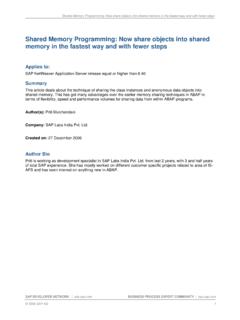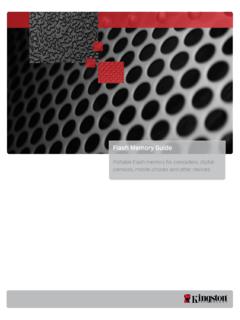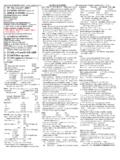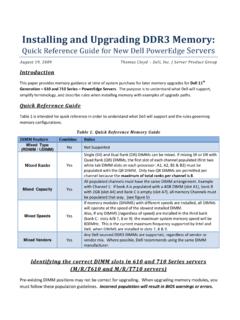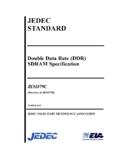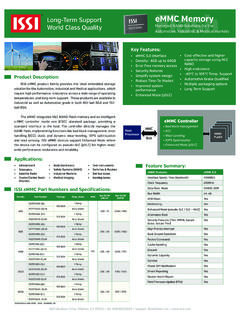Transcription of FRAM -- New Generation of Non-Volatile Memory …
1 FRAM New Generation of Non-Volatile MemoryKey Advantages Speed FRAM has fast access times similar to DRAM. The actual write time is less than 50 is ~1000 faster than EEPROM or Flash Memory making universal Memory reality. Low Power Accesses to the FRAM occur at lower voltages ( V) requiring very little power. EEPROM writes accesses need 10 to 14 V requiring much more power. Lower power Memory enables more functionality at faster transactions speeds. Data Reliability All the necessary power for FRAM is front-loaded at the beginning of data access eliminating data-tearing. FRAM experiences 100 trillion read/write cycles or greater practically is FRAM?
2 FRAM, an acronym for ferroelectric random access Memory , combines the fast read and write access of dynamic RAM (DRAM) with being Non-Volatile (the ability to retain data when power is turned off) and ultra-low power consumption (compared to EEPROM and Flash). In spite of the name, FRAM is not affected by magnetic fields because there is no ferrous material (iron) in the chip. FRAM is being used today in several applications including electronic metering, automotive ( smart air bags), printers, instrumentation, medical equipment, industrialmicrocontrollers and radio frequency FRAM Memory cell consists of a capacitor connected to a plate and bit line.
3 The orientation of the dipole within the capacitor determines whether a 1 or 0 is stored. The dipole orientation can be set and reversed by applying voltage across either of Memory AttributesFRAMEEPROMF lashTime to write 64 bytes to ms2,200 ms6,400 msTime to read 64 bytes from msNumber of write cycles100 trillion500,000100,000 Voltage needed to V10 to 14 V10 to 14 VManufacturing cycle time >3 3 Resistance to gamma radiationYesNoNoFor further information on Texas Instruments FRAM Reliability Data 2008 Test DescriptionConditionsSamples / FailHigh-temperature operating life test1,000 hours at 125 C at maximum supply voltage316 / 0 Data retention1,000 hours at 125 C for same state.
4 85 C opposite state thermal depolarization283 / 0 Intrinsic data 1012 cycles, 25 C for 30 days at nominal supply voltage160 / 0 Intrinsic data retention post cycling100 hours at 125 C same state; 85 C opposite state thermal depolarization158 / 0 Extrinsic data cycling1 108 cycles, 25 C for 30 days160 / 0 High-temperature operating life test100 hours at 125 C at maximum supply voltage160 / 0 Pre-conditioning24 hours at 125 C followed by 192 hours at 30 C / 60% relative humidity, 3 cycles at 260 C160 / 0 Temperature cycle700 cycles, 55 C to 125 C80 / 0 HAST168 hours at 130 C / 85% relative humidity79 / 0 ESD / LU 2,500 V HBM, 800 V, 2 maximum supply voltage at 90 C 33 / 0 FRAM ReliabilityTexas Instruments (TI)
5 FRAM new Generation of Non-Volatile Memory is designed, manufactured and tested to meet the stringent requirements of today and tomorrow. The following tests, per JEDEC industry standard test specifications for Non-Volatile Memory , guarantee 10 years of operation and data retention at 85 C. These test results are a small portion of the testing done continuously at SecurityStudies by a leading security lab have concluded that FRAM s functional features could change the smart card security landscape compared to existing EEPROM technologies. FRAM is more resistant to data corruption via electric fields, radiation, etc. Also, the extremely fast write times and the small 130 nanometer (nm) process node make it more resistant to physical attacks.
6 Furthermore, FRAM s much lower power consumption arguably makes it more difficult to attack with differential power analysis Data Read / Rewrite A data read access from FRAM includes a rewrite of the data back to the same Memory location. This is done within the Memory block automatically. This read/restore operation is similar to DRAM, commonly used in personal electronics. Since FRAM has an inexhaustible write endurance (>100 trillion write/read cycles), this is not a practical ManufacturingWhile the benefits of FRAM have been known for many years, productization at acceptable manufacturing yields has posed challenges to many has been successfully producing FRAM Memory at an advanced process node (130 nm) for over two years.
7 TI s FRAM technology is the result of over 10 years of manufacturing development with well over 200 issued further information on TI s FRAM technology:1. Moise, et al., Demonstra-tion of a 4Mb High-Sensity Ferroelectric Memory Embed-ded within a 130nm, 5LM Cu/FSG Logic Process, Int. Elec. Dev. Meet., 2002, p. J. Rodriguez, et al., Reliability Properties of Low-Voltage PZT Ferroelectric Capacitors and Memory Arrays, IEEE Trans. On Dev. Mat. Reliability, Vol. 4, No. 3, September 2004, p. McAdams et al., A 64Mb Embedded FRAM Utilizing a 130nm 5LM Cu/FSG Logic Process, IEEE J. Solid State Circ., Vol. 39, , 2004., p. J. Rodriguez, et al., Reliability Demonstration Ferroelectric Random Access Memory Embedded within a 130nm CMOS Process, Proceedings of the IEEE Non-Volatile Memory Tech.
8 Workshop, September 2007, pp. 64 platform bar is a trademark of Texas Instruments. 2009 Texas Instruments Incorporat










